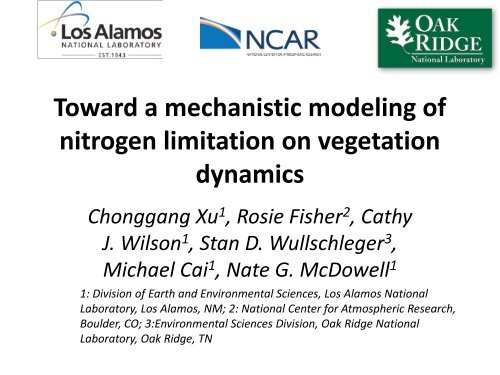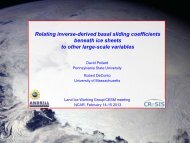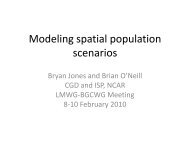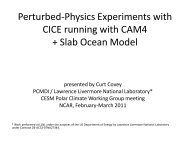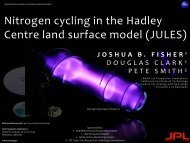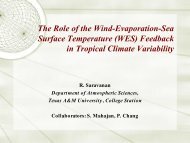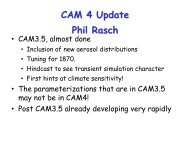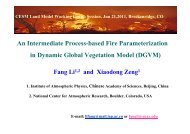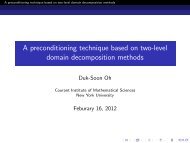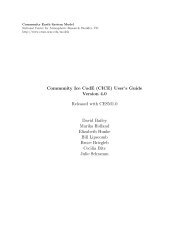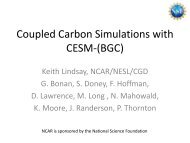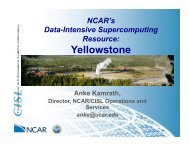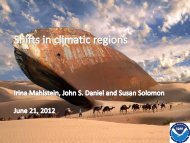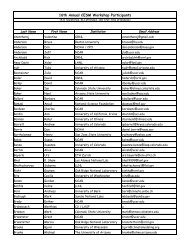Chonggang Xu - CESM
Chonggang Xu - CESM
Chonggang Xu - CESM
Create successful ePaper yourself
Turn your PDF publications into a flip-book with our unique Google optimized e-Paper software.
Toward a mechanistic modeling of<br />
nitrogen limitation on vegetation<br />
dynamics<br />
<strong>Chonggang</strong> <strong>Xu</strong> 1 , Rosie Fisher 2 , Cathy<br />
J. Wilson 1 , Stan D. Wullschleger 3 ,<br />
Michael Cai 1 , Nate G. McDowell 1<br />
1: Division of Earth and Environmental Sciences, Los Alamos National<br />
Laboratory, Los Alamos, NM; 2: National Center for Atmospheric Research,<br />
Boulder, CO; 3:Environmental Sciences Division, Oak Ridge National<br />
Laboratory, Oak Ridge, TN
Soil layers for heat<br />
transfer<br />
cohort2<br />
cohort2<br />
Soil layers for heat<br />
transfer<br />
Sunlit leaf<br />
shaded leaf<br />
cohort1<br />
Cohort2<br />
3 3 3 3<br />
4 4<br />
Litter and soil organic<br />
matter decomposition<br />
based on temperature,<br />
carbon quality, moisture<br />
Leaf layers<br />
cohort1<br />
cohort2<br />
Litter and soil organic<br />
matter decomposition<br />
based on temperature,<br />
Canopy layer 1<br />
Canopy layer 2<br />
CLM-CN<br />
CLM-ED
Farquhar Photosynthesis Model for C3 plants<br />
Photosynthesis rate<br />
Rubisco-limited<br />
carboxylation rate<br />
Light-limited<br />
carboxylation rate<br />
Triose phosphate utilization(TPU)limited<br />
rate<br />
Farquhar, G. D., S. Caemmerer, et al. (1980). Planta 149: 78-90.<br />
Harley & Sharkey. (1991).Photosynthesis Research 27: 169-178.
Approaches for simulating nitrogen<br />
limitation on photosynthesis<br />
1.Down-regulation of NPP by nitrogen supply<br />
and demand;<br />
2. Fixed relationship between Vc,max and leaf<br />
nitrogen content (LNC a), without consideration<br />
differences in light, CO 2 and temperature<br />
conditions.<br />
Vc,max=a + b LNC a<br />
3.Simplified electron transport limitation;<br />
J= uPAR (photosynthetic active radiation)
Vcmax25(umol CO2/m<br />
0 10 20 30 40<br />
Environmental conditions on Vc,max-<br />
Leaf nitrogen relationship change<br />
0.6 1.0 1.4<br />
Leaf nitrogen (g/
Optimal functional nitrogen allocation model<br />
Nitrogen in proteins<br />
of chlorophyll,<br />
Photosystems I, II<br />
Light harvesting<br />
rate<br />
Nitrogen in Rubisco<br />
=<br />
Functional nitrogen=total<br />
nitrogen-structural nitrogen<br />
Nitrogen in<br />
electron transport<br />
enzymes<br />
Electron transport<br />
rate<br />
Electron transport<br />
limited<br />
carboxlation rate<br />
=<br />
Rubisco limited<br />
carboxlation rate<br />
Storage nitrogen<br />
D ns-Days that storage nitrogen<br />
could support the current rate of<br />
growth (i.e., the production of new<br />
plant tissues and metabolic<br />
enzymes) if nitrogen uptake were<br />
to cease altogether.<br />
Gross<br />
photosynthesis<br />
rate<br />
Respiration rate<br />
Respiratory nitrogen<br />
in mitochondrial<br />
enzymes
Leaf-mass-based functional<br />
nitrogen availability<br />
(FNA m)=Total plant functional<br />
nitrogen/total leaf biomass<br />
FNAm, leaf layer 1<br />
FNAm, leaf layer 2<br />
FNAm, leaf layer n<br />
FNA a (1)=LMA(1)*FNAm (1)<br />
FNA a (2)=LMA(2)*FNAm (2)<br />
FNA a (n)=LMA(n)*FNAm (n)<br />
Leaf-area-based functional<br />
nitrogen availability (FNA a)=<br />
FNA m*Leaf mass per area (LMA)<br />
FNAa (1), leaf layer 1<br />
FNAa(2), leaf layer 2<br />
FNAa(2), leaf layer n
Mechanistic<br />
nitrogen<br />
allocation<br />
model<br />
Tuning parameters:<br />
D ns-Days that storage nitrogen could support the<br />
current rate of growth (i.e., the production of new<br />
plant tissues and metabolic enzymes) if nitrogen<br />
uptake were to cease altogether.<br />
fs-Proportion of storage nitrogen allocated to leaf.<br />
Main input parameters:<br />
Radiation; CO 2 (ppm); Daytime<br />
hours; Day T ( o C); Night T ( o C);<br />
Relative humidity; Leaf Mass per<br />
Area (LMA; g/m2); Proportion of<br />
net carbon assimilation allocated<br />
to leaf
Nitrogen investment parameters<br />
Ntrogen use efficiency (NUE; umol CO2/ g N/ s).<br />
Niinemets and<br />
Tenhunen<br />
(1997).Plant Cell and<br />
Environment 20:<br />
845-866;<br />
Evans (1989<br />
Oecologia 78(1): 9-<br />
19.<br />
Leaf nitrogen content<br />
(LNCa; g/m2)<br />
estimation from FNC a
Vcmax25(umol CO2/m<br />
0 10 20 30 40<br />
Test case 1 [D ns=85; fs=0.86 ]<br />
0.6 1.0 1.4<br />
Leaf nitrogen (g/m
Measured Vcmax (umol CO2/m2/<br />
0 50 100 150<br />
Model evaluations<br />
Test case one<br />
Test case two<br />
Test case three<br />
0 50 100 150<br />
Predicted Vcmax(umo<br />
Measured Jmax (umol CO2/m2/s<br />
R 2 =0.953 R 2 =0.943<br />
0 50 100 150 200 250 300<br />
Test case one<br />
Test case two<br />
Test case three<br />
0 50 150 250<br />
Predicted Jmax(umol
Leaf-mass-based functional<br />
nitrogen availability<br />
(FNAm)=Total plant functional<br />
nitrogen/total leaf biomass<br />
FNAm, leaf layer 1<br />
FNAm, leaf layer 2<br />
FNAm, leaf layer n<br />
FNA a (1)=LMA(1)*FNAm (1)<br />
FNA a (2)=LMA(2)*FNAm (2)<br />
FNA a (n)=LMA(n)*FNAm (n)<br />
Leaf-area-based functional<br />
nitrogen availability (FNA a)=<br />
FNA m*Leaf mass per area (LMA)<br />
FNAa (1), leaf layer 1<br />
FNAa(2), leaf layer 2<br />
FNAa(2), leaf layer n
Leaf mass per area(g leaf/m2)<br />
0 100 200 300 400<br />
Leaf nitrogen content<br />
0.01 0.03 0.05<br />
Leaf nitrogen conte<br />
Leaf nitrogen content(g N/m2)<br />
2.00 2.05 2.10 2.15 2.20 2.25<br />
0.00 0.02 0.04<br />
Leaf nitrogen conte<br />
Wright, I. J., P. B. Reich, et al. (2004). Nature 428(6985): 821-827.<br />
Assumption: Leaf mass per area<br />
(LMA) is always adjusted for optimal<br />
leaf-area-based nitrogen content
FNAm=Total functional<br />
nitrogen/total leaf mass<br />
FNAm<br />
FNAm<br />
FNAm<br />
LMA(1)=FNA a (1)/FNAm<br />
LMA(2)=FNA a (2)/FNAm<br />
LMA(n)=FNA a (n)/FNAm<br />
Optimal FNAa(1)<br />
Optimal FNAa(2)<br />
Optimal FNAa(n)
Optimal functional nitrogen availability model<br />
Growing season CO 2,<br />
light and temperature<br />
conditions<br />
Nitrogen allocation model<br />
Nitrogen allocated to light harvesting,<br />
electron transport and carboxylation<br />
Maximum Electron transport rate (Jmax)<br />
Maximum Rubisco-limited rate (Vc,max)<br />
Given functional<br />
nitrogen availability<br />
(FNAa)<br />
Farquhar photosynthesis model & Ball-Berry' model<br />
NPP=smooth_min(Wc, Wj, Wp)-Respiration;<br />
NUE=NPP/(FNAa+ total structural nitrogen in leaf, sapwood and roots) ;<br />
Maximize<br />
W p = 2.0*Rc0*Vc,max0
Net photosynthesis rate(g biomass/m2/d<br />
2 4 6 8<br />
[Dns=50; fs=0.5 ] Vcmax= 42<br />
Wp =33<br />
1 2 3 4 5<br />
Functional nitrogen avail<br />
1 2 3 4 5<br />
Optimum LNCa=1.52 g N/m2<br />
Betula nana (Toolik lake)<br />
Observed=1.57 g N/m2<br />
Leaf area/sapwood area=0.15 m2 /cm2; height=0.5m<br />
Nitrogen use efficiency (g biomass/day/g<br />
1.4 1.5 1.6 1.7 1.8<br />
Functional nitrogen avai<br />
Limbach, et al. (1982). Holarctic Ecology 5(2): 150-157; Shaver, et al. (2001). Ecology 82(11): 3163-3181.
Net photosynthesis rate(g biomass/m2/d<br />
2 4 6 8 10<br />
[Dns=70; fs=0.8 ] Vcmax= 52<br />
Wp =41.6<br />
1 2 3 4 5 6 7<br />
Functional nitrogen avail<br />
Nitrogen use efficiency (g biomass/day/g<br />
1.0 1.1 1.2 1.3 1.4 1.5 1.6<br />
1 2 3 4 5 6 7<br />
Functional nitrogen avai<br />
Optimal LNCa=3.06 g N/m2<br />
Ledum palustre (Toolik lake)<br />
Observed=3.12 g N/m2<br />
Leaf area/sapwood area=0.15 m2 /cm2; height=0.5m<br />
Limbach, et al. (1982). Holarctic Ecology 5(2): 150-157; Shaver, et al. (2001). Ecology 82(11): 3163-3181.
Test ED-N model against nitrogen fertilization observations in the<br />
arctic<br />
Fertilized<br />
Nitrogen Control Fertilized<br />
Inorganic nitrogen 4.0 1 7.6 3<br />
Organic nitrogen 3.0 2 3.0<br />
Soil nitrogen concentration (umol/L) for<br />
control and fertilized plot<br />
Ratio of root biomass to leaf<br />
biomass: 1.5 for deciduous and 0.8<br />
for evergreen.<br />
Deciduous shrub [D ns=50; fs=0.5 ]<br />
Evergreen shrub [D ns=70; fs=0.8 ]<br />
Limbach, et al. (1982). Holarctic Ecology 5(2): 150-157; Shaver, et al. (2001). Ecology 82(11): 3163-3181.
Summary & Next Step<br />
• A dynamic nitrogen allocation model is developed for<br />
ED model to predict the light capture rate, Jmax and<br />
Vc,max change under different environmental<br />
conditions;<br />
• An optimal plant nitrogen model is developed for ED to<br />
predict optimal level of nitrogen under different light,<br />
temperature, CO 2 and soil nitrogen availability<br />
conditions;<br />
• The developed model will be linked with Rosie Fisher’s<br />
leaf optimization model to have more robust<br />
predictions of leaf area index.<br />
• Model limitations: acclimation time and acclimation<br />
ability.
Acknowledgements<br />
This work is funded by Department of<br />
Energy, Office of Science, Biological and<br />
Environmental Research (BER) and Los<br />
Alamos National Lab (LANL) Laboratory<br />
Directed Research and Development<br />
(LDRD) Program. This work is under<br />
public release number: LA-UR-11-<br />
12108.
Test case 2 [D ns=50; fs=0.5 ]<br />
Radiation >0.8 canopy top radiation; Radiation
Vcmax25 (umol CO2/m<br />
50 100 150<br />
1.0 1.5 2.0 2.5 3.0<br />
Test case 3 [D ns=4; fs=0.5 ]<br />
Leaf nitrogen (g/m
Leaf area index optimization<br />
Optimal functional nitrogen<br />
availability, leaf area based (1)<br />
Optimal functional nitrogen<br />
availability, leaf area based (2)<br />
Net Carbon Balance=Yearly NPPconstruction<br />
cost-yearly<br />
respiration(n)<br />
If Net Carbon Balance
CO 2 enrichment effects on V c,max and J max<br />
CROUS et al (2008). Tree Physiology 28, 607–614.
Jmax (umol O 2/m2/s)<br />
Irradiance effect on J max and Chlorophyll<br />
Leaf nitrogen (mmol/m2)<br />
Evans 1989. Oecologia, 78: 9-19<br />
Chlorophyll (mmol/m2)<br />
1.0<br />
0.2<br />
Leaf nitrogen (mmol/m2)
Temperature effects on Vc,max<br />
Vcmax25 (umol CO2/m2/s)<br />
50 100 150<br />
1.0 1.5 2.0 2.5 3.0<br />
Leaf nitrogen (g/m2)
Poplar<br />
(Populus<br />
tremula)<br />
Evaluation of the model<br />
Predicted leaf mass per area (g/m2)<br />
Predicted LMA (g/m 2 )<br />
40 60 80 100 120 140<br />
80 90 100 110 120 130<br />
Observed LMA (g/m 2 )<br />
Observed leaf mass per area
‘storage nitrogen’<br />
• An ideal definition of storage nitrogen would be<br />
the nitrogen stored in plant tissues that is not<br />
involved in any metabolic processes or structural<br />
components (i.e., cell wall and DNA); however, it<br />
would be extremely difficult to quantify the<br />
nitrogen investment for all metabolic processes.<br />
Therefore, to facilitate the development of a<br />
relatively simple nitrogen allocation model, in this<br />
study, ‘storage nitrogen’ is defined as the total<br />
plant nitrogen pool minus the amount of nitrogen<br />
used in structural components, photosynthetic<br />
and respiratory enzymes.
Fn = 2MFNCm/(FNCm+MFNCm)<br />
Dynamic root change<br />
Root to leaf allocations<br />
0.7 0.8 0.9 1.0 1.1 1.2 1.3<br />
0.010 0.015 0.020 0.025 0.030 0.035 0.040<br />
MFNCm<br />
FNCm


